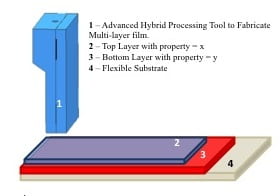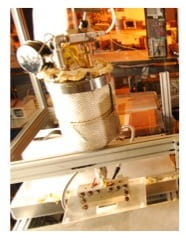Application Areas: Thin Film Manufacturing, Fuel Cell Technology, Flexible Electronics, Water Filtration and Desalination, Manufacturing Tool Design and Development
Casting and Coating on Impermeable Media
The HARRiS group conducts experimental and numerical studies that lead to a predictive model for the processing limits of relatively high viscosity non-Newtonian fluids. We have developed a semi-empirical model to predict the processing limits to manufacture defect-free thin films, from such comlex solutions. These studies will transition the field from a trial-and-error approach to cast or coat high quality polymer thin films. With this work optimal processing speeds for scaled fabrication of high quality polymer thin films can be determined a priori, saving time and money. Furthermore, the R2R-PS, allows for simultaneously capturing the dynamic wetting line and the contact angle, during the casting/coating process. This imaging capability allows for a deeper understanding of the origins of defects and the mechanisms by which bubble pinch-off occurs during the manufacture of thin films. Results from this work helps to better understand moving and forming interfaces that lead to bubbles during polymer thin film manufacture.

The HARRiS group, in collaboration with Dr. Thomas Fuller (Georgia Tech, Chemical and Biomolecular Engineering) conducts study to understand the feasibility of using slot die extrusion to directly coat porous media. A new fabrication process to directly coat a relatively high viscosity non-Newtonian fluids onto porous media has been developed. However, a major limitation of directly coating fibrous porous media is the capability of predicting the penetration depth of the fluid into the pores. Fluid penetration can alter the quality, functionality and performance of the device. The PTFP group is developing analytical models to predict fluid penetration during the coating process.

Virtual Generation of Porous Media
The HARRiS group, in collaboration with Dr. Yan Wang (Georgia Tech, Mechanical Engineering) have introduced a forward engineering modeling approach to virtually generate fibrous porous media. The model allows for control over fiber orientation and fiber angles, which leads to virtual generation of more realistic microstructures that have comparable transport properties to raw material, such as carbon paper. With this model, fibrous porous media with tailored properties can be generated quickly and efficiently, in a non-destructive economical way. In addition, this work is foundational for generating complex porous media (i.e., media that has fibers, binder, and a coated thin film layer) that can be used 1) to predict fluid penetration and 2) to couple the design and manufacture phases of porous media construction.

The HARRiS group develops innovative methods to process multi-layer polymer thin films. Development and implementation of advanced manufacturing methods are necessary, in order for next generation energy devices to see their full potential.

Research Equipment
The HARRiS Group is equipped with a multifunctional modular pilot scale roll-to-roll manufacturing facility (R2R facility), equipped with three distinct tools, flexography/gravure, inkjet printing and slot die coating to fabricate thin and thick films. This R2R facility operates at the pilot scale (speeds up to 120 m/min depending upon which tool is used)). Pilot scale manufacturing is a critical for R&D, as it is a pathway to translate materials discovery from laboratory/bench scale to scalable processes that can then justify major investments for commercialization scale. The R2R facility allows for production of a wide variety of materials and devices for a plethora of applications including energy technologies (solar cells, batteries, fuel cells, etc.), flexible electronics and sensors, soft robotics, pharmaceuticals, separations such as membranes for clean water, and textiles and composites, to name a few. The R2R facility is equipped with the following capabilities:
- Control Systems – web tension, web speed (0.1 m/min – 120 m/min), pumps to control flow rate of a wide range of solutions high/low viscosity fluids, temperature control system, controlled tooling offset from substrate, and precision alignment
- Metrology and Quality Systems – laser thickness measurement system and a detached microscope to quickly characterize a sample
- 3 Coating and Printing Tools (Heads) – slot dies, flexo/gravure printer and inkjet printer, and the ability to attach custom tools that meet the required attachment specifications
- Treatment stations – antistatic devices, chemical pretreatment station, corona treatments, cleaning station and calendaring
- Drying and Curing Stations – 9 meters of in-line drying (4.5 m without nip contact)
- Safety Systems: ventilation and effluent treatments
- Industry 4.0 ready

The HARRiS group uses an advanced, custom designed and built roll-to-roll processing system (R2R-PS) equipped with a slot die, 3D vision, and a novel in-line measurement technique based on optical profilometry and densitometry to study the quality of polymer thin film as they are cast or coated onto a impermeable moving substrate. Real-time, in-line thickness and defect measurements for processing high quality thin films with embedded system feedback can be easily obtained, with the R2R-PS, which aids studying manufacturing defects from their origin.

